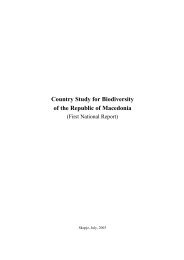CBD Fourth National Report - Azerbaijan (English version)
CBD Fourth National Report - Azerbaijan (English version)
CBD Fourth National Report - Azerbaijan (English version)
You also want an ePaper? Increase the reach of your titles
YUMPU automatically turns print PDFs into web optimized ePapers that Google loves.
Country Study on Biodiversity and <strong>Fourth</strong> <strong>National</strong> <strong>Report</strong><br />
The Republic of <strong>Azerbaijan</strong><br />
A total of 171 species of fungi have been described from Nakhichevan Autonomous Republic,<br />
some of which (notably Phylostica and Septoria spp.) cause agricultural diseases (affecting<br />
tobacco, tea, apple and pear plants, as well as natural vegetation). Further details are shown in<br />
Table 3.3.<br />
1.1.5.4. Flora<br />
Lower plants<br />
Among the lower plants recorded from <strong>Azerbaijan</strong>, some 249 species of algae have been<br />
described from the Caspian Sea, and of these 197 are microscopic (phytoplankton; see Table<br />
3.4). In addition, a high diversity in mosses is recorded from <strong>Azerbaijan</strong>, with 774 species<br />
described from 44 different orders.<br />
Table 3.4 The number of species within the main algal classifications found from the<br />
Azeri area of the Caspian Sea<br />
Group of algae Number of species<br />
Red algae (Rhodophyta) 20<br />
Brown algae (Phaeophyta) 5<br />
Green algae (Chlorophyta) 25<br />
Microscopic species:<br />
Diatoms (Bacilliariopyta) 197<br />
Blue-green algae (Cyanophyta) 80<br />
Dinophyte (Dinophyta) 16<br />
Golden algae (Chrysophyta) 1<br />
In Nakhichevan Autonomous Republic a range of blue-green algae (approximately 25<br />
species) were recently discovered associated with mineral springs, and many of these are<br />
newly described in <strong>Azerbaijan</strong>, being previously only found in other countries. Diatoms have<br />
also been found in these same mineral springs, from which 46 species have now been<br />
identified. Nakhichevan also supports 24 species of mosses.<br />
Higher plants<br />
Approximately 4,500 species of higher plants are recorded in <strong>Azerbaijan</strong> (Table 3.5) , which<br />
represents around 65% of the floral diversity of the Caucasus region, and 11% of the world’s<br />
flora. The main areas of plant diversity in <strong>Azerbaijan</strong> are the highlands of Nakhichevan (60%<br />
of the species occur here), the Kura-Araz plain (40%), the Devechi-Kuba region east of the<br />
Greater Caucasus (38%), the centre of the Lesser Caucasus (29%), Gobustan (26.6%), the<br />
Lenkoran region in the Talysh Mountains (27%), and the Absheron region (22%).<br />
Table 3.5 Number of plant species in different groups<br />
Group<br />
<strong>Azerbaijan</strong> Nakhichevan<br />
Number of species<br />
Briophyta (mosses) 346 39<br />
Sporophyta (ferns and horse tails) 63 14<br />
Gymnosperms (non flowering plants) 24 18<br />
Angiosperms (flowering plants) 4,413 11 2887 12<br />
Total 4,846 2958<br />
Over 2958 species of higher plants have been recorded from the Autonomous Republic of<br />
Nakhichevan (see Table 3.5). Over half of the plants in the country are xerophytpes, but<br />
11 Including 910 monocotyledons, and 3,503 dicotyledons<br />
12 Including 627 monocotyledons and 2260 dicotyledons<br />
33<br />
2009

















